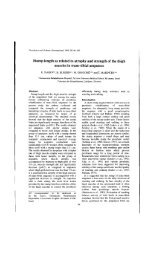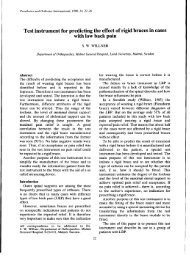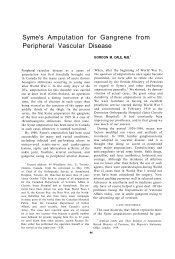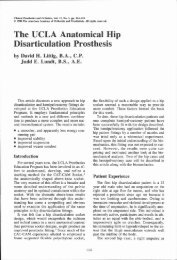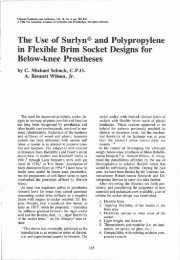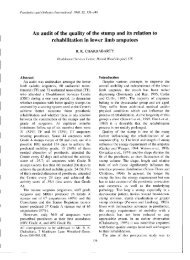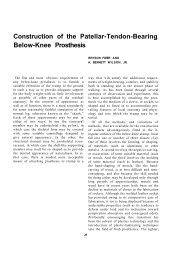The Biomechanics of Control in Upper-Extremity Prostheses
The Biomechanics of Control in Upper-Extremity Prostheses
The Biomechanics of Control in Upper-Extremity Prostheses
Create successful ePaper yourself
Turn your PDF publications into a flip-book with our unique Google optimized e-Paper software.
BIOMECHANICS OF CONTROL 7<br />
Fig. 3. Correct lengths for upper-extremity prostheses.<br />
In the unilateral case, hook length is made to co<strong>in</strong>cide<br />
with normal thumb length, as is also the thumb<br />
length <strong>of</strong> the artificial hand. For bilateral arm amputees,<br />
A = 0.19 X (body height); B + C = 0.21 X<br />
(body height). After Carlyle (J).<br />
ignored <strong>in</strong> the <strong>in</strong>terest <strong>of</strong> the simplicity <strong>of</strong><br />
description that is adequate for the purposes<br />
<strong>of</strong> upper-extremity prosthetics.<br />
THE SHOULDER GIRDLE<br />
Skeletal Members and Jo<strong>in</strong>ts<br />
<strong>The</strong> scapula and clavicle are the chief bones<br />
mak<strong>in</strong>g up the shoulder girdle. Secondarily, the<br />
proximal portion <strong>of</strong> the humerus may be <strong>in</strong>cluded,<br />
s<strong>in</strong>ce the close <strong>in</strong>terarticulation <strong>of</strong> all<br />
three bones at the shoulder jo<strong>in</strong>t gives a considerable<br />
degree <strong>of</strong> coord<strong>in</strong>ated activity among<br />
them and also extends to the complex as a<br />
whole the actions <strong>of</strong> many <strong>of</strong> the muscles<br />
<strong>in</strong>sert<strong>in</strong>g on the <strong>in</strong>dividual members.<br />
without break<strong>in</strong>g. Jo<strong>in</strong>ts are designed for flexion. In<br />
the lower extremity, for example, one speaks not <strong>of</strong><br />
"shank flexion" but <strong>of</strong> "knee flexion," not <strong>of</strong> "thigh<br />
flexion" but <strong>of</strong> "hip flexion." That is, one uses "flexion"<br />
or "extension" not with reference to motion <strong>of</strong> the<br />
distal segment but with reference to the more proximal<br />
jo<strong>in</strong>t. Although Webster accepts the expression "to<br />
flex the arm," he obviously uses the word "arm" <strong>in</strong><br />
the everyday sense <strong>of</strong> mean<strong>in</strong>g the entire upper extremity,<br />
or at least that portion between shoulder and<br />
wrist. Because this loose term<strong>in</strong>ology <strong>in</strong> the upper extremity<br />
is so widely established, not only among workers<br />
<strong>in</strong> prosthetics, it is used throughout this issue <strong>of</strong> ARTI<br />
FICIAL LIMBS, with the understand<strong>in</strong>g that "forearm<br />
flexion" means "elbow flexion," "arm flexion" and<br />
"humeral flexion" mean "flexion <strong>of</strong> the glenohumeral<br />
jo<strong>in</strong>t (and associated structures) " See page 9 et<br />
seq.—ED.<br />
Details <strong>of</strong> the skeletal anatomy <strong>in</strong>volved are<br />
shown <strong>in</strong> Figure 5. <strong>The</strong>re are <strong>in</strong> the system two<br />
jo<strong>in</strong>ts and one pseudo jo<strong>in</strong>t. In the sternoclavicular<br />
jo<strong>in</strong>t, the clavicle articulates with<br />
the sternum <strong>in</strong> a somewhat saddle-shaped<br />
juncture recessed <strong>in</strong> a concavity with<strong>in</strong> the<br />
sternum. <strong>The</strong> biaxial surfaces permit movements<br />
<strong>in</strong> two planes. Ligaments cross<strong>in</strong>g the<br />
jo<strong>in</strong>t prevent displacement <strong>of</strong> the clavicle<br />
anteriorly and laterally. <strong>The</strong> elevation-depression<br />
range is 50 to 60 deg., the flexion-extension<br />
range from 25 to 35 deg.<br />
In the acromioclavicular jo<strong>in</strong>t, the distal<br />
end <strong>of</strong> the clavicle articulates with the scapula<br />
<strong>in</strong> an elliptical juncture which permits a balland-socket<br />
type <strong>of</strong> action. <strong>The</strong> acromioclavicular<br />
ligaments b<strong>in</strong>d the jo<strong>in</strong>t directly.<br />
Strong ligaments from the clavicle to the<br />
coracoid process give important additional<br />
stabilization. <strong>The</strong> range <strong>of</strong> movement is small,<br />
be<strong>in</strong>g only about 10 deg. <strong>in</strong> the frontal and<br />
sagittal planes.<br />
<strong>The</strong> pseudo jo<strong>in</strong>t, the scapulothoracic, is a<br />
muscular suspension which holds the scapula<br />
aga<strong>in</strong>st the thoracic wall but which at the same<br />
time permits translatory and rotatory movements.<br />
A large factor <strong>in</strong> ma<strong>in</strong>ta<strong>in</strong><strong>in</strong>g this jo<strong>in</strong>t<br />
<strong>in</strong> position is barometric pressure, which is estimated<br />
to act upon it with a force <strong>of</strong> 170 lb.<br />
Muscles and Movements<br />
<strong>The</strong> complex arrangement <strong>of</strong> bony elements<br />
is rivaled by the <strong>in</strong>volved nature <strong>of</strong> the muscles<br />
<strong>of</strong> the shoulder girdle and by the <strong>in</strong>tricate<br />
ways <strong>in</strong> which they act upon it. <strong>The</strong> schematic<br />
view <strong>of</strong> Figure 6 presents the fundamentals.<br />
Elevation <strong>of</strong> the shoulder is seen to be brought<br />
about pr<strong>in</strong>cipally by elevators and downward<br />
rotators <strong>of</strong> the scapula, such as the upper<br />
trapezius, the levator scapulae, and the rhomboids.<br />
Although the rhomboids assist <strong>in</strong><br />
elevation, they do not contribute to upward<br />
rotation. Depression <strong>of</strong> the shoulder is mediated<br />
by muscles <strong>in</strong>serted on the scapula, the



